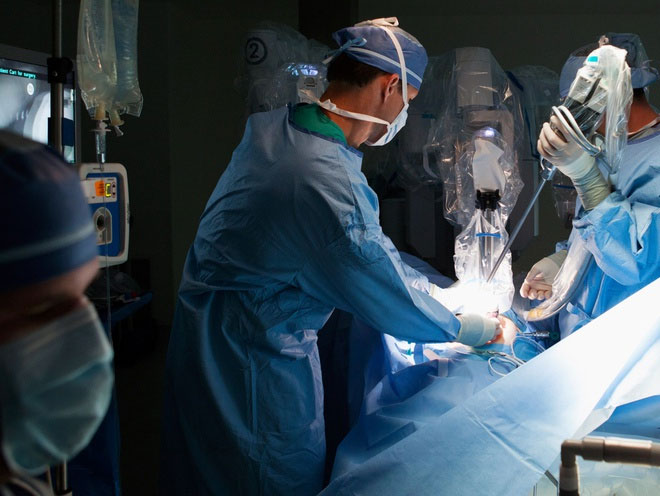Robot watching surgical videos, becoming aide of the doctor
In the future, it is likely that intelligent robots will gradually appear as 'assistants' for doctors in the operating room.
The process of stitching the incision after a patient has surgery is an important task that requires concentration and good techniques from the doctors. Artificial intelligence can help people in this process soon.
A joint venture between Intel Technology Corporation and the University of California, UC Berkeley, led by Dr. Ajay Tanwani, has developed an AI artificial intelligence robot system capable of learning (also known as jutsu). deep-learning language) called Motion2Vec.

Robots have long been expected to appear in operating rooms to aid doctors' work. (Photo: Getty).
Through surgical videos recorded by doctors, Motion2Vec is responsible for observing and analyzing the process as well as surgical movements, the robot system will then imitate and apply the skills learned with high precision.
'With the vast amount of information conveyed in the videos, it is much more effective that the system learns the surgical procedure through visual observation than the traditional methods , ' Tanwani said.
'YouTube is an incredible resource with 500 hours of new data uploaded every minute. We humans are capable of watching and understanding the meaning of videos, on the contrary, robots cannot do that. The system can only recognize videos corresponding to a series of pixels.
Therefore, the goal of this study is to help the robot translate the pixels into a meaningful message , '' said Dr. Ken Goldberg, who runs the UC Berkeley laboratory and advises Dr. Tanwani.
According to Engadget, the team took advantage of Siamese networks, which were built to learn distance functions from unattended or unattended data. Thereby, the team will create high amounts of data in the videos and compress them into a space of many shapes.
Essentially, Siamese networks can rank the level of similarity between two inputs, often used for image recognition tasks such as matching a person's image with their driver's license photo. T
However, in this case, Dr. Tanwani's team is using the Siamese network with the purpose of re-arranging the surgical operations of doctors into the Motion2Vec system, thereby improving the robot's ability to work. the same level with humans.

Motion2Vec will not be assigned to replace humans during surgeries, but only to help. (Photo: Getty).
Based on the semi-supervised learning structure, the research team will only need 78 videos from the JIGSAWS database to train their AI to perform tasks with fractional precision up to 85.5% and false. The average number is only 0.94 cm.
Although it will take years of research to put the robot system into practice, Dr. Tanwani's team believes that, in the future, the technology that uses artificial intelligence applied to surgery will gradually be popularized. turning like autonomous driving on today's vehicles.
Motion2Vec is expected to be in charge of assisting physicians during the near-term operation.
- Russia successfully fabricated new surgical robot
- The surgical robot shows off its incredible abilities by pecking ... a grape!
- Robot replaced the surgeon
- The world first introduced the use of surgical robots in the eyes
- Robots have better surgical capabilities than doctors
- The doctor has a surgical method named after himself 'Dr Luong' receiving Vietnamese record certification
- British scientists have developed the smallest surgical robot in the world
- Robot surgery through the umbilical cord patient
- Sterile surgical robots give people many diseases
- Artificial intelligence robot supports surgery
- Robot revolution in the field of medicine
- Why do we like watching others eat?
 The world's first sexless AI voice
The world's first sexless AI voice This cool t-shirt will make you invisible to AI
This cool t-shirt will make you invisible to AI AI can predict personality only through selfie photos
AI can predict personality only through selfie photos The world-famous chess player lost to Golaxy before, artificial intelligence 'made in China'
The world-famous chess player lost to Golaxy before, artificial intelligence 'made in China'